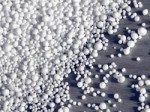Styrofoam touches electrodes to create incredibly fast-charging wonderbatteries

Elon Musk’s heart may have already given up on the humble battery, lusting after capacitors, but researchers at the University of Illinois have think there’s life in the ‘ol cells yet, creating batteries that charge and discharge in seconds . They’ve found a way to create electrodes using polystyrene beads as a sort of substrate, tiny spheres helping to set the porosity of either the nickel-metal hydride or lithium-manganese capacitor material. By adjusting the size and density of the bean bag innards the team was able to create an electrode porosity of 94 percent, which is just a few ticks short of theoretically ideal for exposing the maximum surface area of the electrode to the battery material. This results in extremely fast charges and discharges, the NiMH cell hitting 90 percent capacity in just 20 seconds and discharging in as quickly as 2.7 seconds. While we don’t know just what kind of charging system the team was using to achieve this, even assuming a high-amperage stream of electrons this is still a remarkable feat. But, like most major advances there’s a drawback: similar to Toshiba’s SCiB batts the capacity of these cells is only about three quarters what it would be using normal battery construction, meaning you’d need roughly 25 percent more mass to get the same range in your ultra-fast charging EV of the future. That might just be a worthy trade-off. Styrofoam touches electrodes to create incredibly fast-charging wonderbatteries originally appeared on Engadget on Fri, 25 Mar 2011 00:29:00 EDT. Please see our terms for use of feeds . Permalink


Posted by
on March 24, 2011. Filed under
News,
Tech.
You can follow any responses to this entry through the
RSS 2.0.
You can skip to the end and leave a response. Pinging is currently not allowed.

